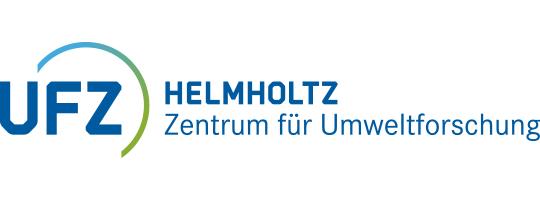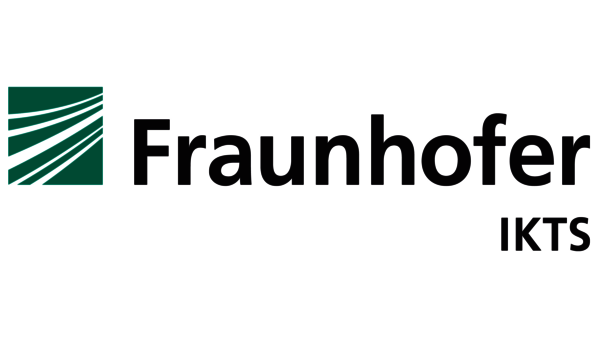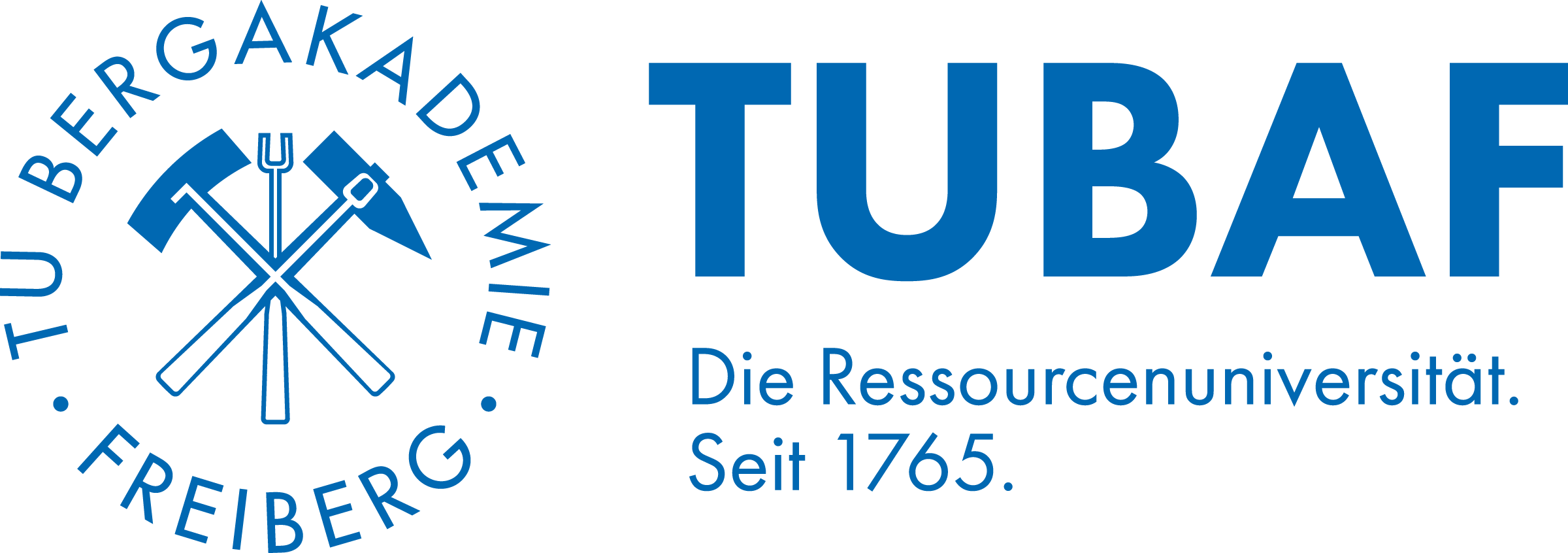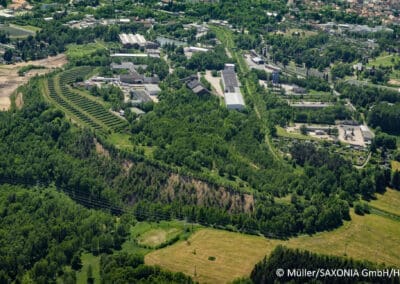Davidschacht Tailing
The Davidschacht waste rock pile, together with the Hammerberg waste rock pile, the Grobbergedamm and the David-Richtschacht waste rock pile, is part of the former Davidschacht mining site. The Davidschacht waste rock pile is located on the north-eastern outskirts of Freiberg, directly on the valley slope to the Freiberger Mulde. Numerous commercial enterprises characterize the image of the Davidschacht site (IBUR, 1995b).
History
The beginning and the end of mining in the Davidschacht
With the construction of the David Shaft, work began in the early 1820s to excavate the old David discovery shafts. In the following decades, the cross-section of the shaft was extended several times. The Davidschacht was part of the former Himmelfahrt-Fundgrube ore mine, which has been documented since 1715 and was the largest mine in Saxony in the middle of the 19th century. After Himmelfahrt Fundgrube was taken over by the state in 1886, the mining equipment was modernized and the site further expanded. An ore washing pond was built in 1888. Like all mines in the Freiberg mining district, the Davidschacht was temporarily closed in 1913 (Fritze, 2000).
Mining was resumed in 1936, mainly for military reasons, and a new ore processing plant was built at the Davidschacht. This marked the beginning of the last operating period, which lasted from around 1937 to 1969 and in which the Davidschacht became the main production shaft of the Himmelfahrt mine alongside the Reiche mine. At 736 m, the Davidschacht is the deepest shaft in the Himmelfahrt mine area (Fritze, 2000). In addition to rope transportation, material transport and mining, the shaft was also used to mine ore for the entire Freiberg and Brand-Erbisdorf mining district from 1963 onwards. It was during this time that the huge slag heaps, which are still visible from afar today, were created. These were heaped up around the actual shaft site, where the winding shaft and surface mining and processing facilities were located. These are the David-Richtschacht coarse waste dump, the Davidschacht waste dump and the Hammerberg waste dump. The flushing dumps consist of the fine flushing sands and sludges from the processing plant, while the coarse mining dumps were filled with coarse tailings (TU Bergakademie Freiberg, 2016).
The Davidschacht slag heap was mainly in operation from 1951 to 1964. It comprises the old flushing basins of the first slag heap, which were constructed in 1943/44 and operated until they were exhausted in 1951, and the industrial tailings management facility (IAA) developed from it, the Davidschacht flushing slag heap (Fritze, 2000).
To seal off the valley, a dam was constructed to the east of the Davidschacht waste rock pile, consisting of coarse gravel material from the coarse gravel pile. The basal part of the western embankment consists of a pioneer embankment with coarse berm material, above which a berm of flushing sand was laid every four meters as the flushing progressed, so that in the final state three berms with a width of 3 – 4 m were created. Every year, around 50,000 m3 to 70,000 m3 of processing sands were injected into the Davidschacht waste rock pile. In 1969, the final closure took place with the end of Freiberg mining (Fritze, 2000).
After the end of mining in Davidschacht
After the end of mining, all mine workings below the Rothschönberger Stolln (230 m above sea level) in the Freiberg mining district were flooded. The former site with the above-ground facilities and buildings of the Davidschacht was assigned to the newly founded rationalization operation of the VEB Bergbau- und Hüttenkombinat “Albert Funk” Freiberg and the organization and computer center (1969 – 1989). The brick-built chimneys of the Davidschacht slag heap were backfilled and the protruding remains were blown up. In 1969/70, the flushing dump was covered with topsoil (Bergarchiv, 1958-1970). Since 1990, numerous exploration measures and planning services have been carried out at the Davidschacht site. The Davidschacht waste rock pile is currently unused.
Projects and activities at the Bielatal Tailing
- Project SMSB: “Extraction of strategic metals and minerals from Saxon mining tailings” as part of the funding measure “r³ -Innovative Technologies for Resource Efficiency – Strategic Metals and Minerals”, 2012 – 2016, project coordination: Helmholtz Institute Freiberg for Resource Technolog
- Project ReMining: “Plant for recovering valuable materials from sulphidic tailings and their environmentally friendly remediation” as part of the funding measure “r + impulse – impulses for industrial resource efficiency”, project coordination: GEOS Ingenieurgesellschaft mbH, 2017-2021
- ReMining Plus project: “Plant for the recovery of valuable materials from sulphide tailings and their environmentally friendly remediation” as part of the funding measure “recomine – resource-oriented environmental technologies for the 21st century”, project coordination: G.E.O.S. Ingenieurgesellschaft mbH; continuation of ReMining, 2020 – 2023
- SULTAN Project: “European training network for the remediation and reprocessing of waste deposits in the sulphide mining”, project coordination: Katholieke Universiteit Leuven, Belgium, 2018 – 2022
- EcoMetals-Project: “Innovative environmentally friendly processes for the extraction of strategic and rare metals from primary and secondary resources”, project coordination: Francoise Bodenan (Bureau de Recherches Géologiques et Minières), France, 2013 – 2017
References (in German)
Büttner, P.; Gutzmer, J. (2016): Re-Mining – Gewinnung strategischer Metalle und anderer Mineralien aus sächsischen Bergbauhalden. In: Mineralische Nebenprodukte und Abfälle, Band 3, Berlin: TK Verlag Karl J. Thomé-Kozmiensky, 2016, 383-393
Frinz, E.; Jahns, C. (2017): Die Spülhalde Davidschacht in Freiberg – Geschichte, Umweltproblematik und geplante Sanierung. Freiberg Ecology online, 2, 2017, 4-17
Fritze, C. (2000): Entwicklungskonzept Gewerbegebiet ,,Am Davidschacht” Freiberg Ebene 3: Altlastenseitige Erfassung.
Klemm, W.; Paul, M.; Jenk, U.; Meyer, J.; Greif, A.; Hartmann, J. (2015): Die Langzeitentwicklung der Belastung von Flutungswässern in Gruben des sächsischen Erzgebirges – Ergebnisse und Schlussfolgerungen. Conference Paper. Conference: Int. Bergbausymposium WISSYM 2015, Bad Schlema, 31.08.-03.09.2015, 87-98
Mollée, R. (2013): Altlastenprojekt SAXONIA 1993 – 2013 eine Retroperspektive., SAXONIA Standortentwicklungs- und -verwaltungsgesellschaft mbH (Hrsg./Verlag), 1. Auflage, Freiberg.
von Seggern, D. (2007): Analyse und Bewertung der Belastung der Freiberger Mulde und der Vereinigten Mulde mit ausgewählten Schwermetallen und Arsen im Zeitraum 2000 bis 2004., Diplom-Arbeit; Universität Leipzig, Fakultät für Physik und Geowissenschaften.
Wagenbreth, O. & Wächtler, E. (1986): Der Freiberger Bergbau. Technische Denkmale und Geschichte., Leipzig.
Contact

SAXONIA Site Development and Management Company mbH
Sabine Meißner
+49 3731 39-5026
sabine.meissner@saxonia-freiberg.de
Documents for download (German)
Drilling in the Davidschacht waste rock pile.jpg
Ore veins of the Freiberg central mining district.png
Inner structure of the Davidschacht waste rock pile.png
Map of the Davidschacht waste rock pile site.jpg
Site plan with sections of the Davidschacht waste rock pile.png
Sectional view of the Davidschacht waste rock pile.png
See on the map
Davidschacht on Google Maps
Further links (German)
The Davidschacht in the Saxon Mining Archives Davidschacht ore washing
Development of the Davidschacht industrial estate
Davidschacht in the Freiberg geo- and environmental portal
The Davidschacht in the German photo library
Objects of investigation
- Drilling fluid
- Leachate-/ Mine water
Pollutants
Cd
Zn
Ni
Cu
Resources
Pb
Cu
Ag
In
Ge
Projects
ReMiningPlus
Development sites:
Freiberg - Davidschacht
Term: From 09.12.2021 to 31.10.2024
A facility for the recovery of valuable materials from sulphide rinsing tailings and their sustainable remediation
Our lead partner:
Social Works
Development sites:
Ehrenfriedersdorf
Freiberg - Davidschacht
Freiberg - Roter Graben
Muldenhütten
Term: 01.01.2020 to 31.10.2022
Analysis of decision-making structures and conflicts and development of a methodological toolkit for transdisciplinary...
Our lead partner: 
ReKuMat
Development sites:
Freiberg - Davidschacht
Term: From 01.08.2021 to 31.07.2024
Development of specific recultivation material for qualified covering of mining dumps and contaminated sites ...
Our lead partner:

VeharstGlass
Development sites:
Ehrenfriedersdorf
Freiberg - Davidschacht
Freiberg - Roter Graben
Muldenhütten
Duration: From 01.04.2023 to 31.12.2025
Our lead partner:


